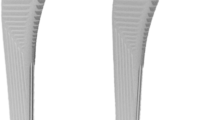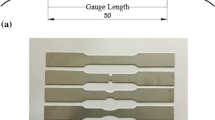We study the structural elements of materials made of bone-cement coupons with various impurities: diethylaminoethyl acrylate, dimethylaminoethyl methacrylate, and diethylaminoethyl methacrylate. With regard for values of the stress intensity factor, we present the characteristics of fracture factors for different times of soaking in simulated body fluid (0; 3; and 6 months) and also for different amounts of impurities in the analyzed material (2–10 wt.%). The data on the stress intensity factors used in the constructed models for different structural elements enable us to analyze possible risks of fracture of these elements in the case where they contain cracklike defects. Moreover, we obtain the values of the critical length of each considered cracklike defect and compute the number of loading cycles in this object that can be useful for the engineering recommendations concerning the tested material and specific structural elements made of this material.




Similar content being viewed by others
References
B. Pascual, M. Gurruchaga, M. P. Ginebra, F. J. Goñi, J. A. Planell, B. Vázquez, J. San Román, and I. Goñi, “Modified acrylic bone cement with high amounts of ethoxytriethyleneglycol methacrylate,” Biomaterials, 20, 453–463 (1999).
A. May-Pata, W. Herrera-Kaoa, J. V. Cauich-Rodrígueza, J. M. Cervantes-Uca, and S. G. Flores-Gallardob, “Comparative study on the mechanical and fracture properties of acrylic bone cements prepared with monomers containing amine groups,” J. Mech. Behav. Biomed. Mater., 6, 95–105 (2012).
V. V. Panasyuk, I. I. Luchko, and I. M. Pan’ko, “Deformation model of fracture of concrete,” Probl. Prochn., No. 2, 18–28 (2003).
I. M. Dmytrakh, L. Tot, O. L. Bilyi, and A. M. Syrotyuk, Serviceability of Materials and Structural Elements with Pointed Stress Concentrators, in: V. V. Panasyuk (editor), Fracture Mechanics and Strength of Materials. A Handbook [in Ukrainian], Vol. 13, Spolom, Lviv (2012).
I. M. Dmytrakh, A. B. Vainman, M. H. Stashchuk, et. al., Reliability and Durability of Structural Elements of the Power-Generating Equipment, in: Fracture Mechanics and Strength of Materials. A Handbook [in Ukrainian], Vol. 7, Akademperiodyka, Kiev (2005).
M. A. Sabino, D. Ajami, D. Salih, N. Nazhat, R. Vargas-Coronado, J. V. Cauich-Rodriguez, and M. P. Ginebra, “Physicochemical, mechanical, and biological properties of bone cements prepared with functionalized methacrylates,” J. Biomater. Appl., 147–161.
Author information
Authors and Affiliations
Corresponding author
Additional information
Published in Fizyko-Khimichna Mekhanika Materialiv, Vol. 53, No. 1, pp. 102–107, January–February, 2017.
Rights and permissions
About this article
Cite this article
Acuña Gonzales, N.A., Bilyi, O.L. & González Sánchez, J.A. Monitoring of the Critical Length of Cracklike Defects in the Bone-Cement Plate with Regard for their Different Geometry. Mater Sci 53, 116–122 (2017). https://doi.org/10.1007/s11003-017-0051-5
Received:
Published:
Issue Date:
DOI: https://doi.org/10.1007/s11003-017-0051-5




